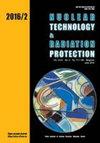核电站事故后用137Cs微污染土修建公路路基的辐射效应评价
IF 0.9
4区 工程技术
Q3 NUCLEAR SCIENCE & TECHNOLOGY
引用次数: 0
摘要
日本福岛核电站事故发生后,产生了大量的放射性污染土壤,这给土壤的处理和处置带来了巨大的挑战。对轻度污染土壤进行循环利用,可以减少污染土壤的数量。分析了137Cs污染土壤在公路路基施工、土袋处理和铺装过程中的主要暴露场景。利用蒙特卡罗算法(Monte Carlo algorithm, MCNP)和RESRAD-ONSITE程序分别模拟了这两种场景,得到了有效剂量为1msv /年时土壤中137Cs的浓度。结果表明:1 Bqg-1 137Cs污染土壤对搬运工和铺路工的年有效剂量分别为0.41 mSv /年和0.23 mSv /年;在1 mSv /年条件下,搬运工和摊铺工土壤中137Cs的活性分别为2.44和4.26 Bqg-1;计算结果与日本原子研究机构报告的结果一致。它们也低于国际原子能机构(IAEA)在低概率事件下每年1毫西沃特有效剂量控制水平所对应的活度浓度。rs - g - 1.7。本文章由计算机程序翻译,如有差异,请以英文原文为准。
Evaluation of the radiation effect on building highway subgrade using 137Cs slightly polluted soil after nuclear power plant accidents
After the accident at the Fukushima nuclear power plant in Japan, a large amount of radioactive contaminated soil was generated, which brought great challenges for treating and disposing of the soil. The recycling of slightly polluted soil can reduce the amount of contaminated soil. This paper analyzes the main exposed scenes of 137Cs polluted soil used in the construction of highway subgrade, soil bag handling and paving. The Monte Carlo algorithm (MCNP) and RESRAD-ONSITE program are used to simulate the two scenes respectively, and the concentration of 137Cs is derived in the soil at the effective dose of 1 mSv per year. It is concluded that: the annual effective doses of porter and paver are 0.41 mSv per year and 0.23 mSv per year respectively caused by 1 Bqg-1 137Cs contaminated soil; the activity of 137Cs are 2.44 Bqg-1 and 4.26 Bqg-1 respectively in the soil at 1 mSv per year for porter and paver; the calculated results are consistent with those reported by the Japan Atomic Research Agency. Also, they are lower than the activity concentration corresponding to the effective dose control level of 1 mSv per year under low-probability events in IAEA No. RS-G-1.7 slightly.
求助全文
通过发布文献求助,成功后即可免费获取论文全文。
去求助
来源期刊

Nuclear Technology & Radiation Protection
NUCLEAR SCIENCE & TECHNOLOGY-
CiteScore
2.00
自引率
41.70%
发文量
10
审稿时长
6-12 weeks
期刊介绍:
Nuclear Technology & Radiation Protection is an international scientific journal covering the wide range of disciplines involved in nuclear science and technology as well as in the field of radiation protection. The journal is open for scientific papers, short papers, review articles, and technical papers dealing with nuclear power, research reactors, accelerators, nuclear materials, waste management, radiation measurements, and environmental problems. However, basic reactor physics and design, particle and radiation transport theory, and development of numerical methods and codes will also be important aspects of the editorial policy.
 求助内容:
求助内容: 应助结果提醒方式:
应助结果提醒方式:


